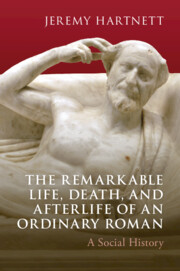Refine search
Actions for selected content:
70 results
An interdisciplinary workflow for the comprehensive study of ancient quarried landscapes
- Part of
-
- Article
-
- You have access
- Open access
- HTML
- Export citation
Introduction
-
-
- Book:
- Relief in Greek, Roman, and Late Antique Art
- Published online:
- 11 October 2025
- Print publication:
- 25 September 2025, pp 1-27
-
- Chapter
- Export citation
9 - Encrusted in Ancestors
-
-
- Book:
- Relief in Greek, Roman, and Late Antique Art
- Published online:
- 11 October 2025
- Print publication:
- 25 September 2025, pp 288-320
-
- Chapter
- Export citation
Chapter 7 - Young children’s semiosis with artworks in residence
-
-
- Book:
- The Arts and Meaning-Making with Children
- Published online:
- 11 September 2025
- Print publication:
- 25 September 2025, pp 141-162
-
- Chapter
- Export citation
6 - Inside Out: Lygia Clark and Clarice Lispector, 1960
-
- Book:
- Rio de Janeiro
- Published online:
- 01 May 2025
- Print publication:
- 19 June 2025, pp 134-163
-
- Chapter
- Export citation
18 - Holocaust Commemoration and Memorials
- from Part IV - Culture and Fields
-
-
- Book:
- The Cambridge History of the Holocaust
- Published online:
- 16 May 2025
- Print publication:
- 12 June 2025, pp 423-445
-
- Chapter
- Export citation
22 - The Holocaust and the Visual Arts: Perplexity, Meanings
- from Part IV - Culture and Fields
-
-
- Book:
- The Cambridge History of the Holocaust
- Published online:
- 16 May 2025
- Print publication:
- 12 June 2025, pp 510-538
-
- Chapter
- Export citation
Chapter 37 - The Victorians’ Shelley
- from Part IV - Afterlives
-
-
- Book:
- Percy Shelley in Context
- Published online:
- 17 April 2025
- Print publication:
- 24 April 2025, pp 284-291
-
- Chapter
- Export citation
Chapter 11 - The Visual and Plastic Arts
- from Part II - Intellectual, Cultural, and Political Contexts
-
-
- Book:
- Percy Shelley in Context
- Published online:
- 17 April 2025
- Print publication:
- 24 April 2025, pp 82-90
-
- Chapter
- Export citation
5 - Papal Tombs in the Middle Ages
- from Part I - Spaces, Liturgies, Travels
-
-
- Book:
- The Cambridge History of the Papacy
- Published online:
- 28 February 2025
- Print publication:
- 20 March 2025, pp 151-185
-
- Chapter
- Export citation
Chapter 2 - A Resuscitating Thing Theory
-
- Book:
- Embodied Experience in British and French Literature, 1778–1814
- Published online:
- 19 December 2024
- Print publication:
- 02 January 2025, pp 82-123
-
- Chapter
-
- You have access
- Open access
- HTML
- Export citation
Chapter 1 - Moving Together
-
- Book:
- Embodied Experience in British and French Literature, 1778–1814
- Published online:
- 19 December 2024
- Print publication:
- 02 January 2025, pp 35-81
-
- Chapter
-
- You have access
- Open access
- HTML
- Export citation

The Remarkable Life, Death, and Afterlife of an Ordinary Roman
- A Social History
-
- Published online:
- 16 December 2024
- Print publication:
- 23 January 2025
The Teynham Triton and Its Significance to the Funerary Architecture of Roman Kent and Beyond
-
- Article
-
- You have access
- Open access
- HTML
- Export citation
A Figurine Wearing a Sleeveless Coat from Sandy, Bedfordshire
-
- Article
-
- You have access
- Open access
- HTML
- Export citation
Chapter 2 - Contrasting Pairs and Twin Graves
- from Part I - Between Literature and Scholarship
-
-
- Book:
- Writing Literary History in the Greek and Roman World
- Published online:
- 07 June 2024
- Print publication:
- 27 June 2024, pp 40-61
-
- Chapter
- Export citation
Chapter 7 - Antioch’s Visual Culture and Its Hellenistic Past
- from Part I - Beginnings
-
-
- Book:
- Antioch on the Orontes
- Published online:
- 06 June 2024
- Print publication:
- 06 June 2024, pp 89-106
-
- Chapter
- Export citation
Implications of Rock Art Aesthetics in Olmec Sculpture
-
- Journal:
- Latin American Antiquity / Volume 35 / Issue 2 / June 2024
- Published online by Cambridge University Press:
- 29 August 2024, pp. 521-541
- Print publication:
- June 2024
-
- Article
- Export citation
15 - Artistic Witness and Response to Environmental Violence
- from Part III - Environmental Violence Impacts, Responses, Resistance, and Alternatives
-
-
- Book:
- Exploring Environmental Violence
- Published online:
- 06 June 2024
- Print publication:
- 09 May 2024, pp 318-339
-
- Chapter
-
- You have access
- Open access
- HTML
- Export citation
Introduction
-
- Book:
- Divine Music in Archaic and Classical Greek Art
- Published online:
- 01 February 2024
- Print publication:
- 29 February 2024, pp 1-29
-
- Chapter
- Export citation
